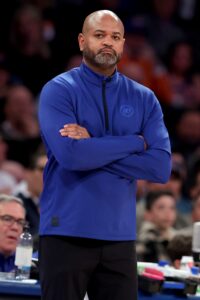The 2023/24 Pistons were one of the worst teams in NBA history. Detroit lost 28 games in a row in the first half and got off to a 4-39 start en route to a 14-68 overall record, which was the worst single-season mark in the franchise’s 76-year existence.
The Pistons hadn’t won more than 23 games in any of the four years prior to ’23/24, but that 14-win showing in a season when they were supposed to take a step forward was an embarrassing low point that prompted an offseason overhaul during the summer of 2024.
 Trajan Langdon replaced Troy Weaver as the head of basketball operations, while J.B. Bickerstaff took over as head coach just one year after Monty Williams received a six-year contract worth a reported $78.5MM. The Pistons’ roster underwent some significant changes too, with Tobias Harris
and Malik Beasley
signing as free agents and Tim Hardaway Jr.
acquired in a trade with Dallas, adding some veteran floor spacers to a team headlined by former No. 1 overall pick Cade Cunningham
.
Trajan Langdon replaced Troy Weaver as the head of basketball operations, while J.B. Bickerstaff took over as head coach just one year after Monty Williams received a six-year contract worth a reported $78.5MM. The Pistons’ roster underwent some significant changes too, with Tobias Harris
and Malik Beasley
signing as free agents and Tim Hardaway Jr.
acquired in a trade with Dallas, adding some veteran floor spacers to a team headlined by former No. 1 overall pick Cade Cunningham
.
It would be difficult to pinpoint which of those specific changes made the biggest difference in Detroit, given that they all worked out pretty much exactly as the club had hoped. Bickerstaff established a hard-nosed, defensive-minded culture, turning a roster that ranked 25th in defensive rating in 2023/24 into a top-10 unit in ’24/25. He finished second in Coach of the Year voting.
The veteran acquisitions, led by Sixth Man of the Year runner-up Beasley, also helped turn things around for a Pistons team that had ranked 29th in the NBA in three-pointers made and 26th in three-point percentage in ’23/24. Detroit still wasn’t exactly raining down three-pointers like the Celtics, but the club improved its rankings in those categories to 20th and 17th, respectively.
Most importantly, with more space to operate on offense, Cunningham enjoyed a breakout year, establishing new career highs in points (26.1) and assists (9.1) per game, as well as field goal percentage (46.9%) and three-point percentage (35.6%). He earned his first All-Star nod, was named to the All-NBA third team, and was a finalist for Most Improved Player.
The Pistons’ year-over-year improvement – from 14 wins to 44 – represented the sixth-biggest turnaround in NBA history and finally gave fans in Detroit a reason for optimism going forward. Even though they were eliminated in the first round of the playoffs, the two postseason wins the Pistons picked up against the Knicks were the most they’d gotten in a season since 2008, when they went to the Eastern Conference Finals.
This version of the Pistons is likely still a little ways off from another conference finals appearance, but it’s extremely encouraging that the organization seems to have the right leaders – Langdon and Bickerstaff – in place and that a protracted rebuild is finally beginning to bear fruit. With several promising young contributors still on the rise and plenty of cap flexibility going forward, Detroit is well positioned to continue clawing its way up the Eastern Conference standings in the coming years.
The Pistons’ Offseason Plan
Cunningham’s breakout season represents a double-edged sword for the Pistons. As thrilled as they must have been to see the former top pick become one of the league’s best guards at age 23, his spot on the All-NBA third team increased the value of his maximum-salary rookie scale extension by a projected $45MM. It will now start at 30% of the 2025/26 cap instead of 25%, adding nearly $8MM in extra salary to the team’s cap for next season.

